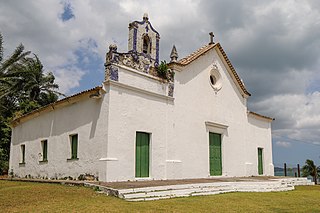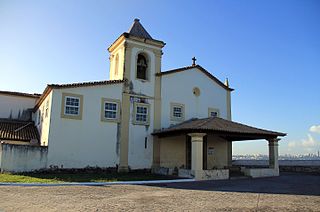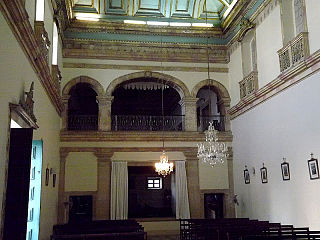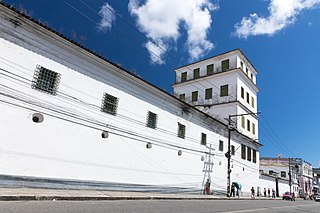
São Cristóvão is a Brazilian municipality in the Northeastern state of Sergipe. Founded at the mouth of the Vaza-Barris River on January 1, 1590, the municipality is the fourth oldest settlement in Brazil. São Cristóvão is noted for its historic city square, São Francisco Square, and numerous early colonial-period buildings. The 3 hectares site was designated a UNESCO World Heritage Site in 2010.

Cachoeira is an inland municipality of Bahia, Brazil, on the Paraguaçu River. The town exports sugar, cotton, and tobacco and is a thriving commercial and industrial centre.

Cairu is a municipality in the state of Bahia in the North-East region of Brazil. The municipality has a population of 18,427 with a population density of 33.3 inhabitants per square kilometer. The municipality consists of three islands: the Island of Cairu, which is only separated from the mainland by a narrow river; Tinharé Island, which has the dense tourist settlement of Morro de São Paulo to the north; and Boipeba Island.

The Basilica of the Immaculate Conception, or the Basilica of the Conception, is a church in Salvador, Bahia, Brazil. It is affiliated with the Catholic Church and was built in 1623, making it one of the oldest parishes in the Roman Catholic Archdiocese of São Salvador da Bahia. It was the first church built by the first governor-general of Brazil, Tomé de Sousa. The current structure was prefabricated in Portugal and assembled in Salvador; its construction began in 1739 and ended in the mid 19th century. The art historian Germain Bazin classifies the church as Portuguese in design, rather than part of the Bahian tradition of religious structures of the 17th and 18th century.

The Church and Convent of Our Lady of Mount Carmel is an 18th-century Roman Catholic church in Cachoeira, Bahia, Brazil. It was constructed between 1688 and likely completed in 1773. The church is dedicated to Our Lady of the Rosary and is constructed in the Baroque style with a Rococo frontispiece. The church opens to Travessa Taváres, a broad avenue, with a view to the Paraguaçu River. The church is dedicated to Our Lady of Mount Carmel.

The Church of the Third Order of Mount Carmel is an 18th-century Roman Catholic church in Salvador, Bahia, Brazil. It is located adjacent to the Church and Convent of Our Lady of Mount Carmel. Work on the church began in 1644. It was destroyed by fire in 1788 and subsequently rebuilt. The church is a large complex consisting of a nave, chancel, choir, corridors, tribunes, meeting rooms, and a sacristy. The interior was richly decorated in the 18th century; the painting of the ceiling of the nave is the first major work by José Teófilo de Jesus. The Church of the Third Order of Mount Carmel was listed as a historic structure by National Institute of Historic and Artistic Heritage (IPHAN) in 1938 and is part of the Historic Center of Salvador UNESCO World Heritage Site.

The Chapel of Our Lady of the Snows is a 16th-century Roman Catholic church located on the Ilha de Maré in the Bay of All Saints, Bahia, Brazil. The island is administratively part of the city of Salvador. The chapel is dedicated to Blessed Virgin Mary and belongs to the Roman Catholic Archdiocese of São Salvador da Bahia. Its construction is dated to 1552, and is among the oldest existing churches in Brazil. It was part of the sugar plantation of André Fernandes Margalho. The nave of the church is narrow, measuring only 6 metres (20 ft) by 15 metres (49 ft). The church was listed as a historic structure by the National Historic and Artistic Heritage Institute in 1958. The historian Mário Mendonça de Oliveira calls it a "one of the gems of old Brazilian religious architecture".

The Church and Monastery of Our Lady of Monserrate is a 16th-century Roman Catholic church and monastery located in Salvador, Bahia, Brazil. The church and monastery are dedicated to Our Lady of Monserrate and belongs to the Roman Catholic Archdiocese of São Salvador da Bahia. It is located 200 metres (660 ft) from the Fort of Monserrate on a rock on the Itapagipe Peninsula. The date of construction of the structure is disputed; it dates to the 16th century, and has seen numerous alterations. The church was built either by the Spanish, or by the group that constructed the Garcia d'Ávila Tower House. Its design, along with that of numerous rural chapels of Bahia, is attributed to the Italian architect Baccio da Filicaia (1565-1628). The church interior was once lined entirely with 16th-century azulejos; now only a single strip of the tiles remain. The church was listed as a historic structure by the National Historic and Artistic Heritage Institute in 1958. It and the Chapel of Our Lady of the Ladder are the only remaining 16th-century chapels in Salvador.

The Church and Hospice of Our Lady of the Good Journey is an 18th-century Roman Catholic church located in Salvador, Bahia, Brazil. The church is dedicated to Our Lady of the Good Journey and belongs to the Roman Catholic Archdiocese of São Salvador da Bahia. It is located on the Itapagipe Peninsula and faces west directly onto the Bay of All Saints. The Church and Hospice of Our Lady of the Good Journey has a single tower with a frontispiece covered in blue and white azulejos in a zigzag pattern. It was listed as a historic structure by the National Historic and Artistic Heritage Institute (IPHAN) in 1938.

The Parish Church of Our Lady of Pilar is an 18th-century Roman Catholic church located in Salvador, Bahia, Brazil. It includes a cemetery, constructed in the Neoclassical parallel to the nave of the church. The interior of the church has an extensive set of azulejo tiles in the rococo style. The historian Carlos Ott dated them to the late 18th century, and stated that they appear to be the work of the Juncal workshop in Portugal. The stonework of the church is in lioz stone, imported from Lisbon at great expense. The art historian Germain Bazin describes the church as a "refinement of forms", due to its long, narrow nave and lack of corridors in the nave.

The Church and Convent of Our Lady of the Palm is a 17th-century Roman Catholic church in Salvador, Bahia, Brazil. The church is dedicated to Our Lady of the Palm and belongs to the Roman Catholic Archdiocese of São Salvador da Bahia. The church was established in 1830, and expanded to house members of the Order of Discalced Augustinians in Salvador and their missionaries from other Portuguese colonies. The church has a simple façade and a single bell tower. In contrast, the church has a richly decorated interior, with paintings, images, furniture, and religious implements from the 16th and 17th century. The Church and Convent of Our Lady of the Palm was listed as a historic structure by the National Institute of Historic and Artistic Heritage in 1938.

The Church and Convent of Our Lady of Solitude is an 18th-century Roman Catholic church and former convent in Salvador, Bahia, Brazil. The church and convent were founded in 1736 and are dedicated to Our Lady of Solitude. The convent has functioned as a school since 1927. The Church and Convent of Our Lady of Solitude is located within the Protected Historic District of Soledade by the State of Bahia.

The Parish Church of Our Lady of Purification is an 18th-century Roman Catholic church located in Santo Amaro, Bahia, Brazil. The church is dedicated to Blessed Virgin Mary and belongs to the Roman Catholic Archdiocese of São Salvador da Bahia. Its construction is dated to 1706. The church was listed as a historic structure by the National Historic and Artistic Heritage Institute in 1958.

The Church of the Third Order of the Blessed Virgin Mary of Our Lady of the Conception of the Mulatto Brothers is an 18th-century Roman Catholic church and former convent in Salvador, Bahia, Brazil. The church was constructed in a neighborhood formerly occupied by mixed-race and Afro-Brazilian artisans. The exterior of the church has an elaborate roccoco pediment and towers; the interior of the church has a Baroque-style ceiling painting in the nave and neoclassical side altars and chancel. The name of the church, boqueirão, refers to a large slope and trench constructed between the high city and low city of Salvador; it served as a defense of the city against foreign invasion. It was listed as a historic structure by the National Historic and Artistic Heritage Institute in 1951.

The Church and Convent of Our Lady of the Exile is a 17th-century Roman Catholic church located in Salvador, Bahia, Brazil. The Convent of Our Lady of the Exile was the first female convent constructed in Brazil. Construction of the convent began in 1681 due to the donation of a large fortune of Dona Antônia de Góis, a member of the order. The church building is noted for its elaborate portal in the Rococo style. Its belvedere was the first in Salvador, followed by that of the Convent of Lapa. The high altar has images of Saint Clare, the founder of the order, and Saint Francis; they date to the mid-18th century. The interior of the church was largely renovated in the Neoclassical style in the 19th century. The church was listed as a historic structure by the National Historic and Artistic Heritage Institute in 1938.

The Convent of Bom Jesus dos Perdões and Chapel of Mercy is an 18th-century Roman Catholic church and convent located in Salvador, Bahia, Brazil. It was listed as a historic structure by National Institute of Historic and Artistic Heritage (IPHAN) in 1943 and is a contributing property of the Historic Center of Salvador UNESCO World Heritage Site.

The Church and Monastery of Our Lady of Grace is an 18th-century Roman Catholic church located in Salvador, Bahia, Brazil. The church is dedicated to Our Lady of Grace and is part of the Roman Catholic Archdiocese of São Salvador da Bahia; it is owned and managed by the Mosteiro de São Bento. It was listed as a historic structure by the National Historic and Artistic Heritage Institute (IPHAN) in 1938.

The Retreat and Church of Our Lady of Humility is a 19th-century Roman Catholic church and women's religious retreat located in Santo Amaro, Bahia, Brazil. It is dedicated to Our Lady of Humility and covers 1,817 square metres (19,560 sq ft). The retreat and church consists of an architectural ensemble of a chapel, a retreat, a seminary, parsonage, forecourt, and side garden. It was listed as a historic structure of the State of Bahia by the IPAC in 1986.

The Church and Convent of Our Lady of the Conception of Lapa (Portuguese: Igreja e Convento de Nossa Senhora da Conceição da Lapa is an 18th-century Roman Catholic church located in Salvador, Bahia, Brazil. The church is dedicated to Our Lady of the Conception and is part of the Roman Catholic Archdiocese of São Salvador da Bahia. It is known as key site in the Brazilian independence movement in the early 19th century. Sister Joana Angélica resisted the invasion of Portuguese troops into the convent and was killed by bayonet in 1822 at the south portal of the convent.
Convent of Our Lady of Mount Carmel or Convent of Nossa Senhora do Carmo may refer to:





















